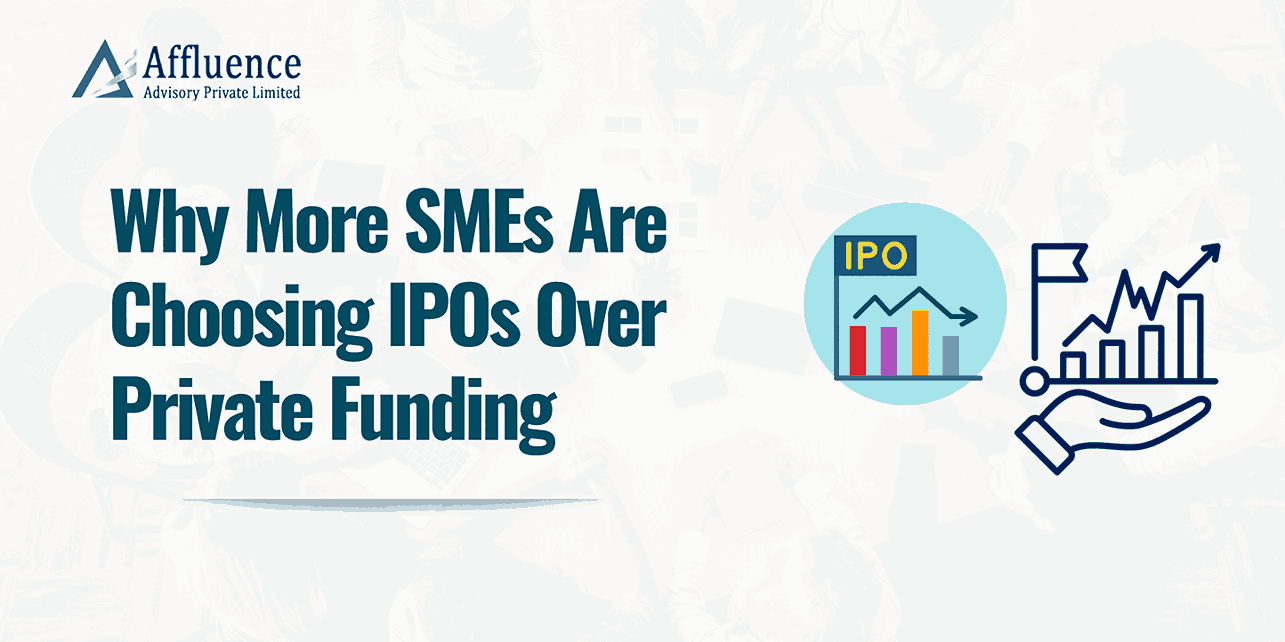The landscape of small and medium enterprise (SME) financing is undergoing a dramatic transformation. While private equity and venture capital have traditionally dominated the funding ecosystem for growing businesses, an increasing number of SMEs are choosing the Initial Public Offering (IPO) route instead. This shift represents more than just a change in financing preferences—it signals a fundamental evolution in how SMEs view growth, control, and long-term value creation.
The SME IPO Revolution
The numbers tell a compelling story. In India alone, 2024 witnessed an impressive 245 SME IPOs successfully listed on BSE SME and NSE Emerge exchanges, marking a significant milestone in the segment’s growth. By 2025, over 180 companies have already debuted on SME platforms, representing a steep 45% jump from the previous year and raising over ₹8,500 crore in total. This surge reflects growing confidence among small and medium businesses looking to tap into public capital markets.
The SME IPO market has become increasingly sophisticated, with companies raising larger amounts of capital. The average ticket size increased from ₹18 crore in 2022 to ₹25 crore in 2023, indicating that while fewer companies may be going public, those that do are accessing comparatively more substantial funding. This trend suggests that larger, more established SMEs are finding the IPO route increasingly viable for their expansion needs.
The Control Dilemma: Why SMEs Shy Away from Private Equity
One of the most compelling reasons SMEs are gravitating toward IPOs is the preservation of control. Private equity and venture capital investments typically come with significant strings attached that can fundamentally alter how a company operates and makes decisions.
Loss of Decision-Making Authority
When SMEs accept private equity funding, they often surrender substantial control over their business operations. PE firms typically take a hands-on approach, involving themselves in major decisions to protect their investment. Founders frequently find themselves losing the final say in critical business decisions, affecting their autonomy and ability to steer the company according to their original vision.
The control issue becomes particularly acute when ownership drops below 50%. Once this threshold is crossed, founders risk losing significant control over strategic decisions. This shift in power often comes with changes in board composition and decision-making dynamics that can be uncomfortable for entrepreneurs who are accustomed to running their own show.
Equity Dilution and Its Hidden Costs
The dilution that comes with private equity funding extends far beyond simple percentage ownership. Each funding round typically results in founders losing 15-20% of their equity, with early rounds often leading to 20-25% dilution. By the time a company reaches Series B, founders typically own less than 30% of their business, while investors hold more than 55%.
This dilution doesn’t just affect ownership percentages—it directly impacts a founder’s ability to guide their company’s vision, direction, and long-term strategy. Early funding rounds are often the “most expensive money” a company ever takes, as founders give up the most equity when their company is valued the least.
The PE Control Structure Challenge
Private equity investors often demand board seats and significant influence in business decisions. They may seek a board seat and participate actively in business decisions, bringing industry expertise and strategic guidance, but this comes at the cost of founder autonomy. The pressure to meet short-term milestones imposed by PE investors can override the larger purpose that originally inspired the company.
MSMEs face additional challenges in accessing private equity, including information asymmetry, poor investment readiness, adverse selection, moral hazards, high risks, and investment management issues. These challenges make the PE route less attractive for many smaller enterprises seeking growth capital.
The IPO Advantage: Transparency and Market-Driven Valuation
Enhanced Transparency and Credibility
Going public through an SME IPO brings multiple transparency advantages that private funding cannot match. Public listing significantly enhances the visibility and credibility of an SME, acting as a stamp of approval that instills confidence among customers, suppliers, and business partners. Being listed on a recognized stock exchange enhances brand recognition and can attract attention from potential customers and strategic partners.
SME IPOs require adherence to strict regulatory standards, promoting accountability and transparency within the company. Following corporate governance guidelines is required for public listing, and this can boost investor confidence substantially. The rigorous regulatory and disclosure requirements associated with being a public company instill confidence among stakeholders regarding the company’s transparency and governance practices.
Also Read: Understanding the Key Differences between SME IPO and Mainboard IPO
Market-Driven Valuation Uplift
One of the most significant advantages of SME IPOs is the market-driven valuation process. Through public offerings, SMEs can determine their market valuation based on actual market demand, enabling price discovery that reflects true investor sentiment. Public companies often enjoy better valuation compared to their private counterparts, with the transparency and regulatory oversight associated with being a public company resulting in higher investor confidence and consequently better market valuation.
Unlike private equity negotiations where valuations may be influenced by factors such as negotiating power and information asymmetries, SME IPOs provide a transparent, market-based valuation mechanism. Once the IPO price is decided with the merchant banker, there is no room for negotiation—all investors, including institutional and retail investors, must apply at the offered price. This transparent pricing mechanism eliminates the subjective elements often present in private equity valuations.
Liquidity and Exit Strategy Benefits
SME IPOs provide immediate liquidity for shareholders, including founders, employees, and early investors, offering them an opportunity to realize the value of their investments. Unlike private equity arrangements where exit pressure may be applied by institutional investors seeking to realize returns, public markets provide continuous liquidity without exit pressure. Any investor can place a sell order anytime on the exchange, providing flexibility that private equity arrangements typically cannot match.
Broader Investor Base and Strategic Flexibility
Access to Diverse Capital Sources
SME IPOs open doors to a much broader pool of investors compared to private funding. While private equity funding targets restricted investor groups, particularly large institutions, public offerings raise funds from a larger group of investors including qualified institutional investors, high net-worth individuals, and retail investors.
This diversification of the investor base provides several advantages. Companies can access substantial amounts of capital from the general public, and the IPO provides larger access to capital than private offerings. The enhanced financial strength and market presence that comes with being publicly traded positions companies better to pursue strategic opportunities such as mergers and acquisitions.
Strategic Advantages for Growth
Once listed, SMEs gain access to additional fundraising mechanisms that were previously unavailable. Public companies can raise further capital through various routes like preferential issues, rights issues, and Qualified Institutional Placements. They can also access debt at more economical rates for expansion purposes.
Listed shares act as a currency for SMEs, especially in business acquisition transactions. With readily tradable stock, SMEs can leverage their market valuation to negotiate favorable deals, expand their product offerings, enter new markets, and pursue strategic partnerships. This strategic flexibility provides public companies with tools for growth that are difficult to replicate in private company structures.
Success Stories and Market Performance
The SME IPO segment has produced remarkable success stories that demonstrate the potential of this funding route. In 2024, several SME IPOs delivered exceptional returns, with Teerth Gopicon leading the pack with returns as high as 372%, followed by companies like Owais Metal and Mineral Processing and Enser Communications, which surged over 300% from their listing prices.
The technology sector has emerged as a frontrunner in the SME IPO space, with tech SMEs uniquely positioned to capitalize on digital transformation trends. Manufacturing companies focusing on innovation, sustainability, and efficiency have also attracted significant investor interest, particularly those aligned with government initiatives like Make in India.
Healthcare SMEs have shown remarkable performance, benefiting from increased health awareness and technological advancements in healthcare delivery. Companies focusing on telemedicine, diagnostics, and pharmaceuticals have been particularly attractive to investors, with the healthcare sector delivering average returns of 78% in recent periods.
The Regulatory Framework Supporting SME Growth
SEBI has created a supportive regulatory framework for SME IPOs that balances investor protection with accessibility for smaller companies. The regulatory requirements for SME IPOs are more relaxed compared to those for larger companies, making the process accessible to smaller enterprises. However, recent tightening of regulations ensures that only credible companies with strong fundamentals enter the market.
Under new SEBI rules, SMEs can launch IPOs only if they report an operating profit of ₹1 crore for at least two of the last three financial years. These measures aim to filter out companies with limited growth potential and protect investor interests while maintaining the accessibility that makes SME IPOs attractive.
Challenges and Considerations
While SME IPOs offer numerous advantages, they are not without challenges. The regulatory compliance requirements, though relaxed compared to main board listings, still require significant preparation and ongoing commitment. Companies must maintain transparency and accurate financial reporting, which can be resource-intensive for smaller organizations.
Market volatility can also affect SME stocks more significantly than larger companies, leading to price swings that may be disconnected from actual company performance. However, companies with strong fundamentals and clear growth strategies have generally weathered these challenges well.
The Future of SME Financing
The trend toward SME IPOs represents a maturation of India’s capital markets and the entrepreneurial ecosystem. As more SMEs successfully navigate the public markets and deliver value to investors, this funding route is likely to become increasingly mainstream.
The success of SME IPOs is creating a virtuous cycle: successful listings attract more companies to consider the public route, while positive investor returns encourage greater participation in SME offerings. This dynamic is supported by increasing retail investor participation, with many investors seeking higher returns from smaller companies with significant growth potential.
The ability to migrate to mainboard listings after three years provides an additional growth path for successful SME companies, creating a clear progression from small public company to major market participant.
Conclusion: A Paradigm Shift in SME Financing
The movement of SMEs toward IPOs over private funding represents more than a temporary trend—it reflects a fundamental shift in how small and medium enterprises approach growth financing. The combination of retained control, transparent market-based valuations, enhanced credibility, and strategic flexibility makes SME IPOs increasingly attractive compared to the control dilution and exit pressures associated with private equity.
As the SME IPO ecosystem continues to mature, with supportive regulations and growing investor confidence, this funding route is positioned to play an increasingly central role in India’s economic growth story. For SMEs ready to embrace transparency and public market disciplines, IPOs offer a compelling path to accessing growth capital while maintaining the entrepreneurial control that drove their initial success.
The data clearly shows that well-prepared SMEs with strong fundamentals can thrive in public markets, often achieving valuations and access to capital that exceed what private funding arrangements might provide. As this trend continues, SME IPOs may well become the preferred route for ambitious small and medium enterprises seeking to scale their operations while preserving their entrepreneurial vision and control.
Disclaimer:This article provides general information existing at the time of preparation and we take no responsibility to update it with the subsequent changes in the law. The article is intended as a news update and Affluence Advisory neither assumes nor accepts any responsibility for any loss arising to any person acting or refraining from acting as a result of any material contained in this article. It is recommended that professional advice be taken based on specific facts and circumstances. This article does not substitute the need to refer to the original pronouncement.
CLICK HERE DOWNLOAD PDF








